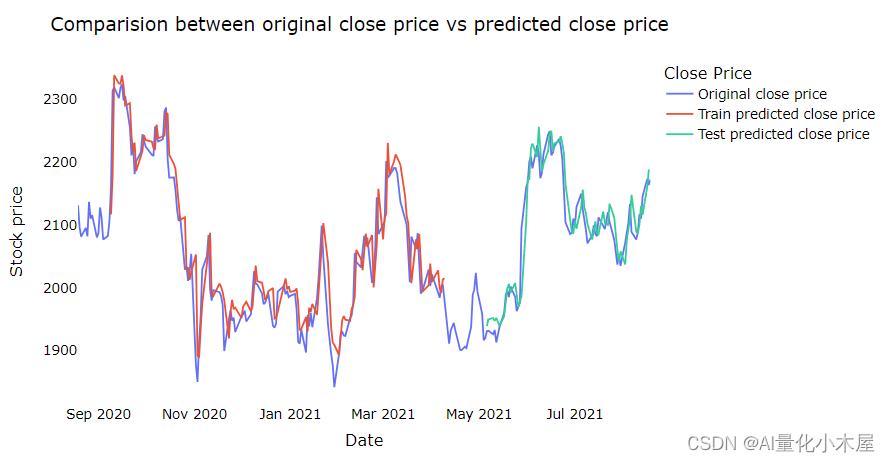牛刀小试-基于LSTM的股票价格预测
发布时间:2024年01月02日
前言
股票价格预测,是量化中的一种常见方式。价格预测属于一种回归任务。一般情况我们是对收盘价进行预测。价格预测的周期可以是日、周或月。
数据预处理
下面我们针对一只美股来演示如何利用LSTM对股票进行预测。
首先我们读取股票的数据:
import pandas as pd
import numpy as np
import math
import datetime as dt
from sklearn.metrics import mean_squared_error, mean_absolute_error, explained_variance_score, r2_score
from sklearn.metrics import mean_poisson_deviance, mean_gamma_deviance, accuracy_score
from sklearn.preprocessing import MinMaxScaler
import tensorflow as tf
from tensorflow.keras.models import Sequential
from tensorflow.keras.layers import Dense
from tensorflow.keras.layers import LSTM, GRU
from itertools import cycle
# ! pip install plotly
import plotly.graph_objects as go
import plotly.express as px
from plotly.subplots import make_subplots
import os
os.environ["CUDA_VISIBLE_DEVICES"] = "1"
# Import dataset
bist100 = pd.read_csv("./RELIANCE.csv")
bist100.head()
对数据的列名进行修改,并检查数据中是否有nan值,删除存在nan值的行
# Rename columns
bist100.rename(columns={"Date":"date","Open":"open","High":"high","Low":"low","Close":"close"}, inplace= True)
bist100.head()
# Checking na value
bist100.isna().any()
bist100.dropna(inplace=True)
bist100.isna().any()
将日期date转化为datetime格式,并进行排序
# convert date field from string to Date format and make it index
bist100['date'] = pd.to_datetime(bist100.date)
bist100.head()
bist100.sort_values(by='date', inplace=True)
bist100.head()
构建数据集
对收盘价数据进行缩放,缩放到0~1之间
closedf = bist100[['date','close']]
print("Shape of close dataframe:", closedf.shape)
fig = px.line(closedf, x=closedf.date, y=closedf.close,labels={'date':'Date','close':'Close Stock'})
fig.update_traces(marker_line_width=2, opacity=0.6)
fig.update_layout(title_text='Stock close price chart', plot_bgcolor='white', font_size=15, font_color='black')
fig.update_xaxes(showgrid=False)
fig.update_yaxes(showgrid=False)
fig.show()
close_stock = closedf.copy()
del closedf['date']
scaler=MinMaxScaler(feature_range=(0,1))
closedf=scaler.fit_transform(np.array(closedf).reshape(-1,1))
print(closedf.shape)
数据集进行切分,训练集占65%,测试集占35%
training_size=int(len(closedf)*0.65)
test_size=len(closedf)-training_size
train_data,test_data=closedf[0:training_size,:],closedf[training_size:len(closedf),:1]
train_data_reshape = train_data.reshape(-1)
test_data_reshape = test_data.reshape(-1)
print("train_data: ", train_data.shape)
print("test_data: ", test_data.shape)
print("train_data_reshape: ", train_data_reshape.shape)
print("test_data_reshape: ", test_data_reshape.shape)
以time_step作为一个周期,构建数据集,这里的time_step为15
# convert an array of values into a dataset matrix
def create_dataset(dataset, time_step=1):
dataX, dataY = [], []
for i in range(len(dataset)-time_step-1):
a = dataset[i:(i+time_step), 0] ###i=0, 0,1,2,3-----99 100
dataX.append(a)
dataY.append(dataset[i + time_step, 0])
return np.array(dataX), np.array(dataY)
# reshape into X=t,t+1,t+2,t+3 and Y=t+4
time_step = 15
X_train, y_train = create_dataset(train_data, time_step)
X_test, y_test = create_dataset(test_data, time_step)
print("X_train: ", X_train.shape)
print("y_train: ", y_train.shape)
print("X_test: ", X_test.shape)
print("y_test", y_test.shape)
构建LSTM模型
# reshape input to be [samples, time steps, features] which is required for LSTM
X_train =X_train.reshape(X_train.shape[0],X_train.shape[1] , 1)
X_test = X_test.reshape(X_test.shape[0],X_test.shape[1] , 1)
print("X_train: ", X_train.shape)
print("X_test: ", X_test.shape)
tf.keras.backend.clear_session()
model=Sequential()
model.add(LSTM(32,return_sequences=True,input_shape=(time_step,1)))
model.add(LSTM(32,return_sequences=True))
model.add(LSTM(32))
model.add(Dense(1))
model.compile(loss='mean_squared_error',optimizer='adam')
model.summary()
模型训练
model.fit(X_train,y_train,validation_data=(X_test,y_test),epochs=100,batch_size=5,verbose=1)
模型预测
### Lets Do the prediction and check performance metrics
train_predict=model.predict(X_train)
test_predict=model.predict(X_test)
# Transform back to original form
train_predict = scaler.inverse_transform(train_predict)
test_predict = scaler.inverse_transform(test_predict)
original_ytrain = scaler.inverse_transform(y_train.reshape(-1,1))
original_ytest = scaler.inverse_transform(y_test.reshape(-1,1))
计算各种指标
# Evaluation metrices RMSE and MAE
print("Train data RMSE: ", math.sqrt(mean_squared_error(original_ytrain,train_predict)))
print("Train data MSE: ", mean_squared_error(original_ytrain,train_predict))
print("Test data MAE: ", mean_absolute_error(original_ytrain,train_predict))
print("-------------------------------------------------------------------------------------")
print("Test data RMSE: ", math.sqrt(mean_squared_error(original_ytest,test_predict)))
print("Test data MSE: ", mean_squared_error(original_ytest,test_predict))
print("Test data MAE: ", mean_absolute_error(original_ytest,test_predict))
print("Train data explained variance regression score:", explained_variance_score(original_ytrain, train_predict))
print("Test data explained variance regression score:", explained_variance_score(original_ytest, test_predict))
# R-squared (R2) is a statistical measure that represents the proportion of the variance for a dependent variable that's explained by an independent variable or variables in a regression model.
#1 = Best
#0 or < 0 = worse
print("Train data R2 score:", r2_score(original_ytrain, train_predict))
print("Test data R2 score:", r2_score(original_ytest, test_predict))
# Regression Loss Mean Gamma deviance regression loss (MGD) and Mean Poisson deviance regression loss (MPD)
print("Train data MGD: ", mean_gamma_deviance(original_ytrain, train_predict))
print("Test data MGD: ", mean_gamma_deviance(original_ytest, test_predict))
print("----------------------------------------------------------------------")
print("Train data MPD: ", mean_poisson_deviance(original_ytrain, train_predict))
print("Test data MPD: ", mean_poisson_deviance(original_ytest, test_predict))
画图对比原始收盘数据和预测收盘数据
# shift train predictions for plotting
look_back=time_step
trainPredictPlot = np.empty_like(closedf)
trainPredictPlot[:, :] = np.nan
trainPredictPlot[look_back:len(train_predict)+look_back, :] = train_predict
print("Train predicted data: ", trainPredictPlot.shape)
# shift test predictions for plotting
testPredictPlot = np.empty_like(closedf)
testPredictPlot[:, :] = np.nan
testPredictPlot[len(train_predict)+(look_back*2)+1:len(closedf)-1, :] = test_predict
print("Test predicted data: ", testPredictPlot.shape)
names = cycle(['Original close price','Train predicted close price','Test predicted close price'])
plotdf = pd.DataFrame({'date': close_stock['date'],
'original_close': close_stock['close'],
'train_predicted_close': trainPredictPlot.reshape(1,-1)[0].tolist(),
'test_predicted_close': testPredictPlot.reshape(1,-1)[0].tolist()})
fig = px.line(plotdf,x=plotdf['date'], y=[plotdf['original_close'],plotdf['train_predicted_close'],
plotdf['test_predicted_close']],
labels={'value':'Stock price','date': 'Date'})
fig.update_layout(title_text='Comparision between original close price vs predicted close price',
plot_bgcolor='white', font_size=15, font_color='black', legend_title_text='Close Price')
fig.for_each_trace(lambda t: t.update(name = next(names)))
fig.update_xaxes(showgrid=False)
fig.update_yaxes(showgrid=False)
fig.show()
结果图:

结论
从结果图可以看出,其实预测价格的趋势是挺准确的,但是如果需要预测具体的价格,确实模型很难做到,因此我们更倾向于通过模型的预测知道股票的价格在未来几天市涨或者跌,从而选择时机进行购入,而不能坚信股票价格能达到具体多少的价位。
文章来源:https://blog.csdn.net/sinat_21250935/article/details/135269710
本文来自互联网用户投稿,该文观点仅代表作者本人,不代表本站立场。本站仅提供信息存储空间服务,不拥有所有权,不承担相关法律责任。 如若内容造成侵权/违法违规/事实不符,请联系我的编程经验分享网邮箱:chenni525@qq.com进行投诉反馈,一经查实,立即删除!
本文来自互联网用户投稿,该文观点仅代表作者本人,不代表本站立场。本站仅提供信息存储空间服务,不拥有所有权,不承担相关法律责任。 如若内容造成侵权/违法违规/事实不符,请联系我的编程经验分享网邮箱:chenni525@qq.com进行投诉反馈,一经查实,立即删除!
最新文章
- Python教程
- 深入理解 MySQL 中的 HAVING 关键字和聚合函数
- Qt之QChar编码(1)
- MyBatis入门基础篇
- 用Python脚本实现FFmpeg批量转换
- 《深度学习工业缺陷检测》专栏介绍 & CSDN独家改进实战
- 概率论与数理统计————1.随机事件与概率
- java异常
- 谷歌浏览器HTTP自动跳转HTTPS
- 复试 || 就业day13(2024.01.09)算法篇
- 一个适合用来搭建资源网站的整站打包代码,集成了全开源的ripro主题,效果非常棒
- 搭建谷歌 Gemini,体验谷歌版GPT4
- MySQL-约束
- 消息队列RabbitMQ.01.基本使用
- STANFORD斯坦福FS725铷钟